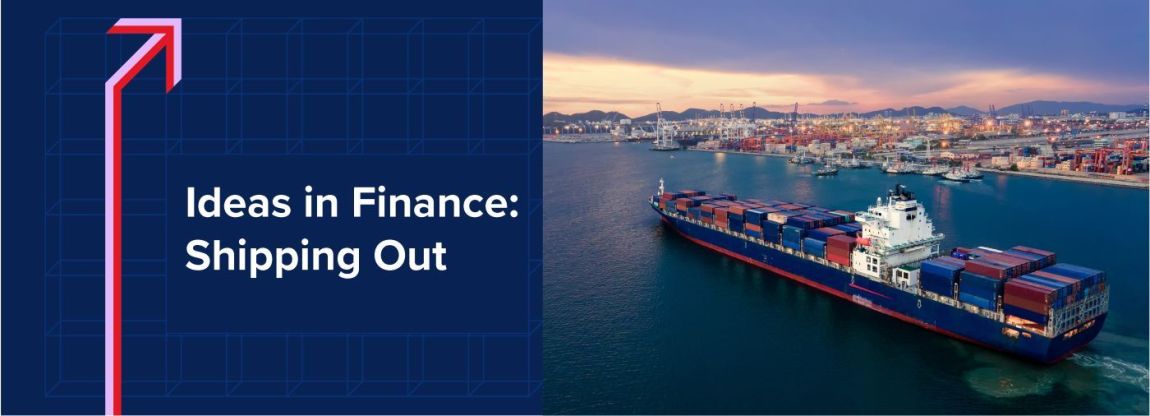Ideas in Finance: Shipping Out
You go to a major retailer’s website and buy an item. You expect to get it quickly. Within a few days at most. To satisfy customer demand and expectations, companies must have sufficient inventory on hand. However, additional inventory ties up capital that could, at least, be earning the short-term rate of interest. Companies face a trade-off. Part of managing this trade-off is knowing how quickly they can replenish their warehouses. If everything runs smoothly, they can keep the customers satisfied without holding excess inventory or, worse, finding themselves unable to fill customer orders for days or weeks.
This leads us to the complex topic of global shipping. About 80 percent of goods travel by sea. Companies trying to manage their supply chains want to know how much it’s going to cost them to get things shipped and how long it’s going to take. During the pandemic there was a massive increase in the cost of shipping per container. At one point in late 2021 it cost $5,000 (USD) per container, five times the cost pre-pandemic. That price has since fallen back closer to $1,000 (USD) per container (AFR, January 16, 2023). Note, though, that the AUD price went from about $1,200 (AUD) to $6,800 (AUD) back to $1,875 (AUD). The weakening of the Australian dollar vs the US dollar has kept AUD shipping costs around double the pre-pandemic level.
Part of the reason why the price has fallen is that people stopped buying as much as they did during the pandemic. But there’s more to it. According to CNBC (August 24 2023), shipping companies ordered record numbers of new vessels after finding themselves flush with pandemic-era cash. This extra capacity obviously reduces the price (more supply, lower the price). CNBC also notes that many sailings are being cancelled because there’s not enough demand to fill the ships. The reason for this appears to be more worrying. It seems that retailers in Europe and America are holding huge amounts of extra inventory. They don’t want to add more to their stocks because, as mentioned above, this costs them money every day they’ve got cash tied up in unsold inventory. Some commentators think that only Christmas sales will clear it out.
The reliability of global shipping is something that we take for granted. Nobody sits around with fingers crossed hoping that the ships get through. We just expect that they will. But there are two critical routes where everything must go smoothly to ensure this happens.
First, the Suez Canal. The Suez Canal connects the Red Sea to the Mediterranean. If you look at a map, you can see that the Red Sea runs out along the Gulf of Aden (famous for pirates during the 2000s and 2010s) into the Indian Ocean. The Suez Canal, built in the 1860s, allows ships from Asia to avoid going all the way around the southern tip of Africa and up the west coast to the UK and Europe or across to the United States. The time saved is between 1 and 2 weeks of sailing time, which saves fuel, labour etc. The extra distance involved in going the long way is about 5,000 nautical miles. Around $1 trillion (USD) of goods, 12% of global trade, 30% of container traffic, and around 20,000 ships pass through the Suez Canal each year (NZ Foreign Affairs and Trade 2021).
Second, the Panama Canal. The Panama Canal connects the Atlantic to the Pacific. This allows ships to travel from New York to Los Angeles without going all the way around the tip of South America. Of course, this also allows ships from China, say, to sail across the Pacific, through the Canal and up to New York or across to Europe without travelling the extra and much more difficult 4,000 nautical miles, saving around 2 weeks of travel time. According to CNBC (June 24 2023), 40 percent of U.S. container traffic goes through the Panama Canal. In total, almost $300 billion of goods are shipped through the Canal each year. You can imagine the difficulty and cost that would be incurred if these two routes were disrupted.
But there have been problems in the past. The Suez Canal was blocked for days just a few years ago when a container ship became wedged across the Canal. This was despite the Canal being widened in 2014 from 61 meters to 312 meters. The Suez Crisis in 1956 saw the Canal closed for about 6 months.
While the Suez Canal is a sea level passage from the Red Sea to the Mediterranean which allows ships to sail through, the Panama Canal relies on a more complicated system than one might think. If you think you just sail through the Panama Canal, think again. It’s not that easy. The Panama Canal uses “locks”, which are sections of water with gates. Water is pumped in from a nearby lake, raising a ship 26 meters above sea level. The ship then steps through each of the locks before being lowered down to sea level on the other side. The problem being faced in 2023 is a water shortage from the lake. This has instigated various discussions about upgrading the Panama Canal or, possibly, building an alternative route through Nicaragua.
For companies relying on international shipping to keep their warehouses at just the right capacity, enough to keep customers satisfied without keeping too much working capital tied up, two narrow waterways in far-off parts of the world are vital to the effective management of inventories. They probably should have their fingers crossed and hope that nothing goes wrong.
Discussion Question
What are the financial implications of shipping costs? How does the strength of a country’s currency affect these costs (measured in USD)? Can you find out how much extra it costs to ship goods “the long way round”?

